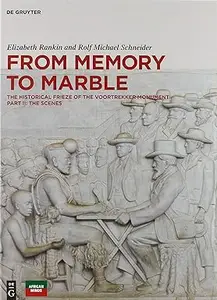From Memory to Marble The historical frieze of the Voortrekker Monument Part II The Scenes

Free Download From Memory to Marble: The historical frieze of the Voortrekker Monument Part II: The Scenes
by Elizabeth Rankin, Rolf Michael Schneider
English | 2020 | ISBN: 311061524X | 664 Pages | PDF | 47 MB
For the first time, the 92-metre frieze of the Voortrekker Monument in Pretoria, one of the largest historical narratives in marble, has been made the subject of a book. The pictorial narrative of the Boer pioneers who conquered South Africa’s interior during the ‘Great Trek’ (1835-52) represents a crucial period of South Africa’s past. Conceptualising the frieze both reflected on and contributed to the country’s socio-political debates in the 1930s and 1940s when it was made. The book considers the active role the Monument played in the rise of Afrikaner nationalism and the development of apartheid, as well as its place in post-apartheid heritage.
The frieze is unique in that it provides rare evidence of the complex processes followed in creating a major monument. Based on unpublished documents, drawings and models, these processes are unfolded step by step, from the earliest discussions of the purpose and content of the frieze, through all the stages of its design, to its shipping to post-war Italy to be copied into marble from Monte Altissimo, up to its final installation in the Monument. The book examines how visual representation transforms historical memory in what it chooses to recount, and the forms in which it is depicted. The second volume expands on the first, by investigating each of the twenty-seven scenes of the frieze in depth, providing new insights into not only the frieze, but also South Africa’s history.
François van Schalkwyk of African Minds, co-✅Publisher with De Gruyter writes: From Memory to Marble is an open access monograph in the true sense of the word. Both volumes of the digital version of the book are available in full and free of charge from the date of publication. This approach to publishing democratises access to the latest scholarly publications across the globe. At the same time, a book such as From Memory to Marble, with its unique and exquisite photographs of the frieze as well as its wealth of reproduced archival materials, demands reception of a more traditional kind, that is, on the printed page. For this reason, the book is likewise available in print as two separate volumes. The printed and digital books should not be seen as separate incarnations; each brings its own advantages, working together to extend the reach and utility of From Memory to Marble to a range of interested readers.